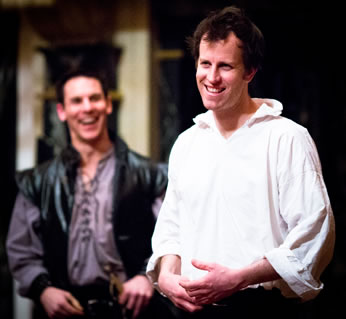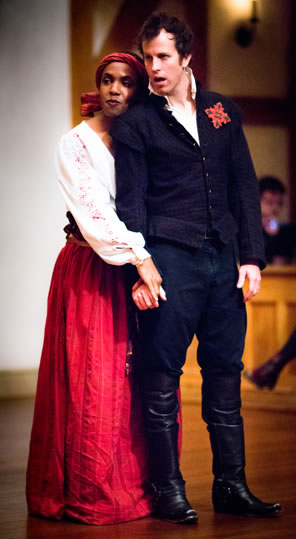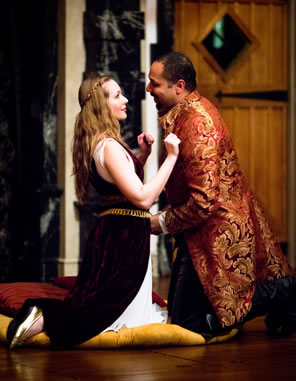The White Devil
A Scintillating Discovery
By John Webster
American Shakespeare Center, Blackfriars Playhouse, Staunton, Va.
Saturday, March 28, 2015, C–3&4 (center stalls)
Actors' Renaissance Season

Flamineo (Chris Johnston, right) and Lodovico (Patrick Midgley) keeps close tabs on him in the American Shakespeare Center production of John Webster's The White Devil at the Blackfriars Playhouse. Below, Flamineo stands with his mistress and Vittoria's maidservant, Zanche (Nathan C. Crocker). Bottom, Vittoria (Sara Hymes) and Brachiano (René Thornton Jr.) profess their love for each other. Photos by Lindsey Walters, American Shakespeare Center.
Actors who specialize in early modern classic theater—the Elizabethan era through the Restoration—will generally tell you how much superior William Shakespeare is to his peers and the playwrights in his immediate wake. He has no near rival in language skills and verse composition. The characters he creates are unparalleled. His dramatic instincts are among the keenest.
However, these same actors will light up when they come across a gem in the canon of a playwright not named Shakespeare, and you can see that in the eyes and the drive and the nervy verve of the American Shakespeare Center’s Actors’ Renaissance Season troupe as it polishes John Webster’s jewel The White Devil. First performed in 1612, The White Devil is full of salacious sex, greed-fueled subterfuge, and bizarre murder, but it also has incredibly complex characters speaking audition-piece speeches of roiling human passion and psychosis.
Well then: This company of actors has passed its auditions—big time.
In particular, Chris Johnston as Flamineo is ready for his Iago, if not his Hamlet. Through four acts, the man seems the ultimate mercenary villain. He hooks his married sister Vittoria up with his boss, the Duke of Brachiano. He conspires in the murder of Brachiano’s wife, Isabella, and Vittoria’s husband, Camillo. He engages in various conspiracies according to which way the political winds are blowing. With a slyly ironic grin and his mind moving at a hyperkinetic pace, Johnston romps through much of the play, carrying the bulk of the lines and always seeming to end up at the center of the action.
His real truth emerges in the fifth act, “We think caged birds sing, when indeed they cry,” he says, and this turns out to be the foundation of Johnston’s portrayal all along as The White Devil turns out to be, in many ways, the tragedy of the man who has brought so much tragedy to others. Born into the outskirts of noble society, he has neither the social status nor the family wealth to become anything more than Brachiano’s secretar, and this denial of nobility despite its proximity goads him on. Commercial greed factors into his motivation, but so does an urgent need to be respected, and by the fifth act he has become an inwardly howling madman. He kills his own brother Marcello out of pique and then chastises his mother for mourning so much over Marcello’s body. Flamineo later goads Vittoria and her servant (and his mistress) Zanche into shooting him; then revealing that the pistols are loaded with blanks and, now with the clear evidence of their disdain for him, sets to killing them instead. He is forestalled, but we’ll not get into that here, not because it would be a spoiler but because the plot by this time has become so convoluted with disguises and noblemen tricking each other into acts of mayhem that I’m not sure I could even adequately explain what forestalls Flamineo from killing his sister—except that I’m certain it’s not his soul that intervenes.
The play has a lot of moving parts, and Flamineo is only moving some of them. The action opens with the banishment of an Italian count named Lodovico (Patrick Midgley), and though the exact cause of his banishment is not clear and he becomes a key participant in subsequent acts of revenge, his purpose seems to be setting the play’s moral tone, that wealthy noblemen get away with illicit behavior while the rest are penalized—but those wealthy noblemen eventually will get their comeuppance. Webster seems to be setting off on his way to a typical revenge tragedy, but The White Devil splays into buckshots of various revenge plots and, along the way, detours into formal set-piece scenes in which the playwright takes on various moralistic discussions. This being Webster, however, the play also gets quite macabre. Murders include the breaking of a neck in a gym to look like an accidental fall, poison on a portrait, and poison in a fencing helmet that burns through the victim’s scalp—and then that victim appears later as a ghost: gruesome.
Heck, I’m not even quite sure which character is the White Devil. There are no real heroes in this play. Brachiano (René Thornton Jr.) is supposedly the central tragic hero; but with his unbridled lust for Vittoria equaled only by his unbridled disdain for his wife, and the way he so self-centeredly embraces and then casts each aside according to expediency makes him nothing more than a scumbag. The Duke of Florence, Francisco de' Medici (Christopher Seiler), who is the brother of the wronged and later murdered Isabella, might be justified in carrying out his own revenge plot, but he seems nothing more than a master politician, Machiavellian to the core. Marcello (Benjamin Reed) seems like a nice guy with high ethical standards, but he does harp at his brother a bit too harshly (not enough to be murdered for it, I grant), and he is in doting service to Francisco (which means that while he might not be morally bankrupt, he is at least dimwitted). The Cardinal Monticelso (John Harrell) becomes Pope Paul IV—we even get to see a papal election in this play—but whatever color the ecclesiastical robes he wears the fabric can’t fully cover up the moral turpitude peering out underneath.
 However, this play is full of heroines, each earning that label in singular ways. Isabella (Bridget Rue) is ultrapious and shows tremendous dignity as she faces up to Brachiano’s philandering ways. This devotion ultimately does her in, though, as she dies by kissing the poisoned lips on a portrait of Brachiano. Cornelia (Allison Glenzer) is the long-suffering mother of Flamineo, Marcello, and Vittoria, ever advising them like a fire-and-brimstone preacher to follow the straight and narrow path of family bonds. The fratricide among them is her tragedy, her good mothering being trampled by socio-economic pressures. Zanche (Nathan C. Crocker), the Moore servant to Vittoria and mistress to Flamineo, looks to be a bit part at first, but she turns out to be a most heroic warrior when her lady is under attack, first by Flamineo and then by Lodovico.
However, this play is full of heroines, each earning that label in singular ways. Isabella (Bridget Rue) is ultrapious and shows tremendous dignity as she faces up to Brachiano’s philandering ways. This devotion ultimately does her in, though, as she dies by kissing the poisoned lips on a portrait of Brachiano. Cornelia (Allison Glenzer) is the long-suffering mother of Flamineo, Marcello, and Vittoria, ever advising them like a fire-and-brimstone preacher to follow the straight and narrow path of family bonds. The fratricide among them is her tragedy, her good mothering being trampled by socio-economic pressures. Zanche (Nathan C. Crocker), the Moore servant to Vittoria and mistress to Flamineo, looks to be a bit part at first, but she turns out to be a most heroic warrior when her lady is under attack, first by Flamineo and then by Lodovico.
The centerpiece female of this play, though, is Vittoria (Sara Hymes), a leading candidate for the titular role, and yet an engagingly complex character way ahead of her time. In her own time, audiences might not have known what to make of her; she is labeled as “the famous Venetian courtesan” in the title of the play’s quarto publication, but that descriptor is dropped when the play’s title is repeated atop the start of the text. She could be considered a courtesan on the basis of Flamineo being repeatedly referred to as a panderer as he arranges her trysts with Brachiano, and she does gain some economic reward involved in that relationship. Or, she simply could be the wife of a fool (Camillo, as played by Michael Amendola) deeply in love with the fascinatingly complicated and suave Brachiano. In the performances of Hymes and Thornton, Vittoria and Brachiano love and fight with as much passionate intensity as any romantic couple I’ve ever seen on stage, including Antony and Cleopatra.
However, Vittoria is no mere plaything. After Isabella’s murder she is brought to trial on morals charges, where she turns the tables on the viciously moral attacks by Cardinal Monticelso. “Terrify babes, my lord, with painted devils, I am past such needless palsy," she says to him, "for your names of Whore and Murd’ress, they proceed from you, as if a man should spit against the wind, the filth returns in’s face.” She outlasts almost everybody else in the play and shows so much grounded wisdom throughout the action that her last line comes off as yet another keen truism and perhaps the play’s ultimate moral: “O happy they that never saw the court, nor ever knew great men but by report.”
 Convoluted though Webster’s plot may be, it's lines like these that so endear this play to actors, and the actors in this production turn the script into scintillating theater. Thornton tackles the part of Brachiano with relish befitting the character of Brachiano, and he and Hymes match each other in intensity. Speaking of intensity, nothing comes close this Renaissance season to the electric argument between Flamineo and his mother, Cornelia: Johnston and Glenzer go verbally toe-to-toe, each line shot off as emotionally charged darts aimed right for the heart. In my notes I simply wrote, “wow!”—yes, the exclamation mark is in my notes, too.
Convoluted though Webster’s plot may be, it's lines like these that so endear this play to actors, and the actors in this production turn the script into scintillating theater. Thornton tackles the part of Brachiano with relish befitting the character of Brachiano, and he and Hymes match each other in intensity. Speaking of intensity, nothing comes close this Renaissance season to the electric argument between Flamineo and his mother, Cornelia: Johnston and Glenzer go verbally toe-to-toe, each line shot off as emotionally charged darts aimed right for the heart. In my notes I simply wrote, “wow!”—yes, the exclamation mark is in my notes, too.
Cross-gendering is a norm with the American Shakespeare Center, but it is usually done in earnest respect for the part, and that’s the case here. You want a valiant Moor in the maidservant Zanche, and Crocker plays her with equal parts grace and strength and never ever winking at the cross-dressing involved. You want a strong-willed Giovanni, son of Brachiano and Isabella, coming of age amid swirling conspiracy, and Lauren Ballard handles that role with aplomb.
I should make the obligatory mention that in the Actors’ Renaissance Season, the company stages five plays using the production procedures Shakespeare’s original company used: no director, no design team (Thornton came up with his ghost look on his own), and only about a week’s time for the cast to rehearse and stage the play in the Blackfriars Playhouse, which replicates Shakespeare’s original staging conditions of bare stage, universal lighting, and audience crowding in on the stage itself. Many marvel that the company manages to consistently mount solid, tightly acted productions under such conditions. I marvel every time, too, but I also enjoy when the actors are clearly inspired by the text that they are, for the most part, discovering for the first time just ahead of the audience who, for the most part, are also discovering it for the first time.
Eric Minton
May 7, 2015
Comment: e-mail editorial@shakespeareances.com
Start a discussion in the Bardroom



 Find additional Shakespeareances
Find additional Shakespeareances